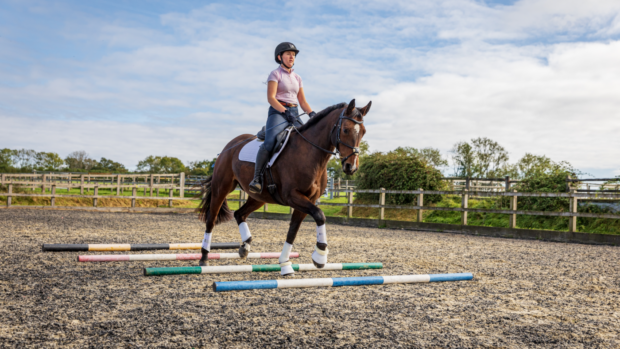British team dressage medallist Michael Eilberg shares the innovative ways he uses poles to help develop young horses’ early training, from corners and circles to counter canter and lateral work
1. Arrange poles around your arena as per the diagram, below
“I use a three figure approach with my young horses: circles, to check the horse is loose and supple; straight lines, to check you can control the bend, that you don’t have to have it if you don’t want it; and corners, to represent more control and the introduction of collection,” says Michael. “Everything you do in an arena is made up of four straight line and four corners, so they always have to be good.”

2. Use the poles around the edge to help you ride better corners
“Ride around the pole to help push your horse into the corner so you don’t have to do too much with your aids,” advises Michael. “Then turn across the school between B and E and ride through parallel poles to give the horse direction and keep him straight so you don’t have to be too strong with your aids.”
3. Ride circles of varying sizes around the poles in canter, to help develop strength and the first steps towards teaching collection
“The canter in the smaller circle might get a bit more laboured as the horse has to work harder, so you need a more active aid to keep the energy in the canter,” says Michael. “The bigger circle then offers more relief, where you can send him forward.”
4. Now make circles in between two of your corner poles, rather than around them
“This works them a bit harder, and they may get tense. Even if your horse gets strong, try to let go — don’t be strong back,” says Michael, who advises taking the horse onto a bigger circle, or down the straight line after a couple of smaller circles, to allow him to relax.
“The minute you get the opportunity to soften, you must soften — you have to make the first move yourself sometimes.”
5. Use this arrangement of poles to start teaching counter canter
To start counter canter, ride a small half circle around the pole coming out of the corner, then a loop back towards the track at B or E. At the middle marker, ride back towards the centre line and make a half circle round the pole at the other end.
“Don’t panic if you can’t get all the way to the track at first,” says Michael. “Work on challenging the horse’s balance and getting closer. Try to be black and white with your corrections; say, ‘Not like this, like this’.
“If the rhythm gets too fast in the loop, wait for the circle at the end to catch the speed — you don’t have to pull.”
6. In between exercises, give your horse a chance to stretch, and check he’s relaxed
“When you’re stretching a horse, all the same things still matter,” points out Michael. “You still want him to be rhythmic and balanced, just with a longer neck. You don’t want him to fall on the floor with his nose.”
7. Rearrange your poles as per the second diagram, below, to use them to help introduce young horses to the early stages of lateral work

“When starting lateral work, don’t forget that it has to be forwards and sideways, not just sideways,” says Michael. “Using poles helps give direction, and they give the horse confidence because he knows where he’s going.”
8. The first lateral movement Michael teaches his young horses is the leg yield
Make a half circle in trot and ride down the outside of the diagonal line of poles, back towards the track to start the leg yield.
“Push the quarters away from the poles — the horse needs to understand how to be more reactive off the leg.”
In between, add some transitions to check the horse is staying reactive to your aids, and to maintain a quality trot.
“The horse must learn to understand going sideways without losing a good trot. You’re always looking to not have to work too hard,” says Michael.
9. Progress to using the poles to help teach a horse to half-pass, using travers
“The hardest thing about half-pass is positioning the horse correctly — the quarters are often leading or there is not enough bend,” points out Michael. “By riding travers down the outside of the diagonal pole line you are already more-or-less doing half-pass. The beauty of it is that every time you ride it you’re getting the same half-pass and it starts to feel familiar. The poles help keep the horse in position and rhythm and you can ride positively forward as you know where your line is.”
- To stay up to date with all the breaking news throughout London International and more, subscribe to the Horse & Hound website
You may also be interested in:

Learn how to strengthen your horse at home using polework

7 polework exercises to keep your horse interested

Subscribe to Horse & Hound magazine today – and enjoy unlimited website access all year round




